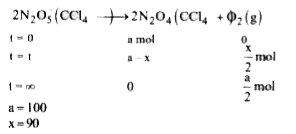The decomposition of N2O5 in carbon tetrachloride was followed by measuring the volume of O2 gas evolved : 2NO2O5(CCl4)→2N2O4(CCl4)+O2(g). The maximum volume of O2 gas obtained was 100cm3. In 500 minutes, 90cm3 of O2 were evolved. The first order rate constant (in −1min) for the disappearance of N2O5 is:
2.303500
2.303500log10090
2.303500log90100
10010×500
The correct Answer is:A

k=1tInaa−x=2.303500
Topper's Solved these Questions
- CHEMICAL KINETICS BOOK - DISHA PUBLICATIONCHAPTER - CHEMICAL KINETICS EXERCISE - EXERCISE 1 : CONCEPT BUILDER (TOPICWISE)(TOPIC 3 : Theories of Rate of Reaction)
17 Videos
- CHEMICAL BONDING AND MOLECULAR STRUCTURE BOOK - DISHA PUBLICATIONCHAPTER - CHEMICAL BONDING AND MOLECULAR STRUCTURE EXERCISE - EXERCISE-2: CONCEPT APPLICATOR
30 Videos
- CHEMISTRY IN EVERDAY LIFE BOOK - DISHA PUBLICATIONCHAPTER - CHEMISTRY IN EVERDAY LIFE EXERCISE - Exercise
88 Videos
Similar Questions
The decomposition of N2O in carbon tetrachloride was followed bymesuring the volume of O2 gas evolved : 2N2O5(CCL4)→2N2O4(CCL4)+O2(g) . The maximum volume of O2 gas obtained was 100 cm3. In 500 minutes, 90 cm of O2 were evolved. The first order rate constant (in −1min for the dissaperance of N2O is :
View SolutionThe following data were obtained during the first order thermal decomposition of N2O5 (g) at constant volume :
2N2O5(g)→2N2O4(g)+O2(g)

Calculate the rate constant.
View Solution
Knowledge Check
The decomposition of N2O in carbon tetrachloride was followed bymesuring the volume of O2 gas evolved : 2N2O5(CCL4)→2N2O4(CCL4)+O2(g) . The maximum volume of O2 gas obtained was 100 cm3. In 500 minutes, 90 cm of O2 were evolved. The first order rate constant (in −1min for the dissaperance of N2O is :
A2.303500B2.303500log10090C2.303500log90100D10010×500The decomposition of N2O5 in chloroform was followed by measuring the volume of O2 gas evolved :
2N2O5(CC4)→2N2O4(CCl4)+O2(g). The maximum volume of O2 gas obtained was 100cm3. In 500 minutes, 90cm3 of O2 were evolved. The first order rate constant (in −1min) for the rate of disappearance of N2O5 isA2.303500B2.303500log10090C2.303500log90100D10010×500For the first order reaction
2N2O5(g)→4NO2(g)+O2(g)AThe concentration of the reaction decreases exponentially with timeBThe half-life of the reaction decreases with increasing temperatureCThe half-life of the reaction depends on the initial concentration of the reactantDThe reaction proceeds to 99.6 % completion in eight half-life duration
Write the oxyacids of the following oxides: N2O3,N2O5,N2O4
View SolutionThe decomposition of N2O5 in a carbon tetrachloride solution has been investigated.
N2O5(solution)→2NO3 (solution) +1/2O2(g) . The reaction has been found to be of the first order in N2O5 with a first order rate-constant = 6.2×10−4s−1. Calculate the rate of the reaction when (a) [N2O5] = 1.25 mol L−1 and b) [N2O5] = 0.25 mol L−1. b) What concentration of N2O5 would give a rate of 2.4×10−3molL−1s−1 ?
View SolutionThe following data were obtained during the first order thermal decomposition of N2O5(g) at constant volume:
2N2O5(g)→2N2O4(g)+O2(g)

View SolutionFor the first order reaction
2N2O5(g)→4NO2(g)+O2(g)
View SolutionThe decomposition of N2O5 is a first order reaction represented by
N2O5→N2O4+12O2
After 15 minutes the volume of O2 produced is 9 cc and at the end of the reaction 35 cc The rate constant is equal to
View Solution
